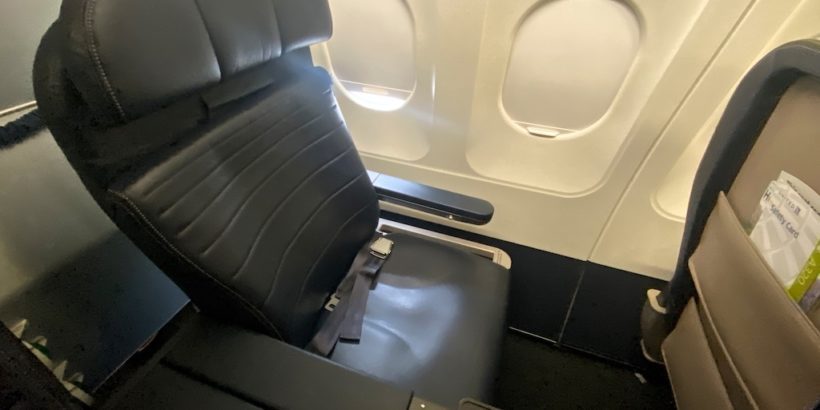It’s no secret that when it comes to airlines cleaning their planes, sometimes there is a lot to be desired.
Between each flight, you would expect basic cleaning like surfaces getting wiped down, trash removed, and linens replaced, etc.
But even those basic cleaning measures fail sometimes.
For example, I recently flew first class on United from Houston to Dallas and I found the armrest tray at my seat to be covered in salt from a prior flight.
Clearly, that surface had not been wiped down — much less even looked at. And I’m sure that my seat was not the only one that received subpar attention.
But now that we are in the time of the coronavirus pandemic there is no margin for error when it comes to cleaning planes.
I thought it was interesting to see what some airlines were doing to keep their planes disinfected from the virus.
First, let’s start with the World Health Organization.
They recently published guidelines for disinfecting planes and their guidelines are pretty straightforward.
If there are no symptomatic passengers, they just recommend the airline to follow routine operating procedures for cleaning.
The problem with that is just because passengers were not symptomatic that does not mean that they did not leave virus particles behind.
As already shown above, airlines don’t always follow those routine operating procedures for cleaning.
I would like to think that there would be a heightened sense of responsibility right now to do that. And airlines have voiced that they are extra committed to wiping down commonly touched surfaces in planes.
But based on my personal experiences I just don’t trust airline employees to properly sanitize so I would still bring my own disinfectant wipes and hand sanitizer on any flight I had to take over the next couple of months. (Note that some airlines like JetBlue are providing passengers with sanitizing wipes.)
If there has been a symptomatic passenger identified then the WHO recommends airlines to take extra precautions to clean surfaces within 6 feet in all directions of where the passenger sat.
For hard surfaces like armrests, tray tables, seat belt latches, light and air controls, etc., they are recommended to use disinfectant products with EPA-approved emerging viral pathogens expected to be effective against the virus that causes COVID-19.
Enhanced cleaning in a 6 foot radius sounds good but I would prefer the entire plane to be de-sanitized and luckily that appears to be happening for some routes.
Some airlines like Delta are taking things up a notch and performing sanitization with fogging machines.
For certain routes, they are spraying down the entire cabin with disinfectant that has proven to be highly effective against many communicable diseases, including coronaviruses. You can watch a video of how this is done here. United is apparently also working on implementing this as well.
The crew is also changing how they do things during the flight.
If you like those hot towels in first class, you may no longer get those for a while and your flight crew might be wearing masks/gloves when they serve you drinks and food. Dishes are reportedly going through extra sanitization before washing as well.
The one thing that really worries me is that airlines will inevitably feel pressure from their decreased revenue. We’ve already seen their stocks tumble over the last week and they are slashing routes by the day at unprecedented levels.
Pressure like that can force executives and others within companies to cut corners. So when it comes to decisions like whether or not to throw out leftover materials from a flight or whether to err on the side of being extra cautious and going the extra mile to sanitize cabins and items, I wonder if that pressure could lead to some airlines cutting corners?
I mean, I’ve personally witnessed corners being cut in the past so should I really be confident that things will be that much better in a state of scarcity?
Maybe the threat of a public safety issue will be enough to raise the bar for airlines to do their jobs. I don’t know. But what I do know is that I would try to avoid all nonessential flight travel right now. And if I chose to fly, I would try to limit it to areas where the outbreak is subdued.
And most of all, I would take things into my own hands by not relying on airlines to sanitize my seating area. That means bringing along my own sanitation wipes and hand sanitizer and trying to minimize contact with tray tables, in-flight entertainment screens, air controls, etc.
If I had a proper N95 mask, I would most likely wear that on a flight, especially if I heard a few coughs off in the distance.
Again, the virus doesn’t really scare me that much due to the facts.
I’ve personally been hit with an epidemic-like condition before (Zika) and it didn’t stop me. But I would hate to ever transmit a disease like COVID to someone I am close to or to someone at risk so I am the type of person that would like to take all the precautions I can.
Daniel Gillaspia is the Founder of UponArriving.com and the credit card app, WalletFlo. He is a former attorney turned travel expert covering destinations along with TSA, airline, and hotel policies. Since 2014, his content has been featured in publications such as National Geographic, Smithsonian Magazine, and CNBC. Read my bio.


I don’t trust the airlines or hotels to properly clean anything, because they just don’t. So, I take major precautions before settling in my seat or bed.
That old saying….if you want something done right, do it yourself holds true in these situations.
I pretty much feel the exact same way!